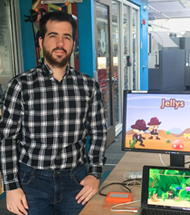The "perfect place" to build a video game that improves reading skills of children with dyslexia
Mikel Ostiz, PhD student of ICS, is staying at Carnegie Mellon University to develop the version that will be used for the first tests of the game.

PHOTO: Courtesy
Rhythm affects reading and can be used as an intervention to help people with dyslexia. This is the idea behind the videogame that Mikel Ostiz Blanco is carrying out in his doctoral thesis , which he is developing in the Institute for Culture and Society (ICS) of the University of Navarra, the Basque Center on Cognition Brain and Language (BCBL) and the University of Vic.
In order to advance in the development of the game and achieve a version with which to make the first tests, Mikel made a six-month stay at the high school of Human Computer Interaction Institute (Human Computer Interaction Institute) at Carnegie Mellon University (Pittsburgh, USA). This is possible thanks to two grants from the Banco Sabadell Foundation and the Caja Navarra Foundation, in addition to the scholarship of the Obra Social "La Caixa" that finances his thesis .
As he explains, "it is the perfect place to build it," since this center is considered one of the most prestigious worldwide at Applied Engineering for accessibility and people with special needs.
Mikel is working during these months together with Jeff Bigham, an expert in human-machine interaction, and Luz Rello, an expert in computer applications to help people with dyslexia. He is also expanding his knowledge in the fields of assessment of the usability of a computer tool or the analysis of human-machine interaction.
"It's a privileged environment to develop a tool like mine, so the video game will be able to reach a level that would not have been possible without the stay," he says.
Improve pacing and visual attentionThe video game, called Jellys, aims to help improve the reading skills of children with dyslexia through rhythm training and visual attention. In it, activities will take place in different "worlds" to which the characters, a boy or a girl explorer, will travel. The characters will have to find and capture the jellys through rhythm or visual attention exercises.
Back in Pamplona, Mikel will perform the first tests of the game together with DISNAVARRA (association de Dislexia de Navarra) to delimit the human-machine interaction of children with and without dyslexia. The effectiveness of the game will be finally evaluated in a high school in Pamplona during the 2018-2019 academic year.
